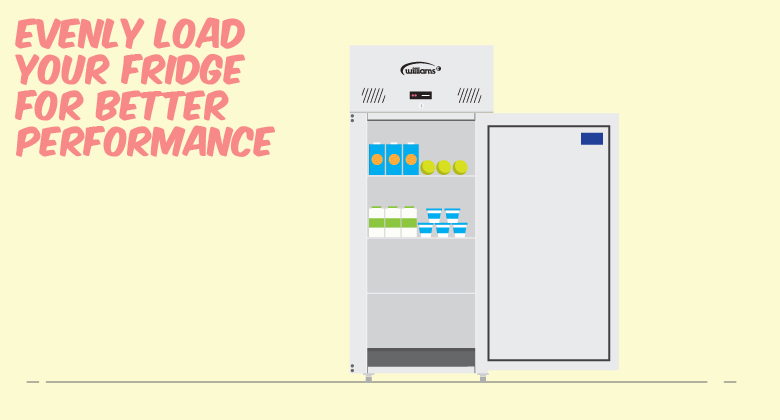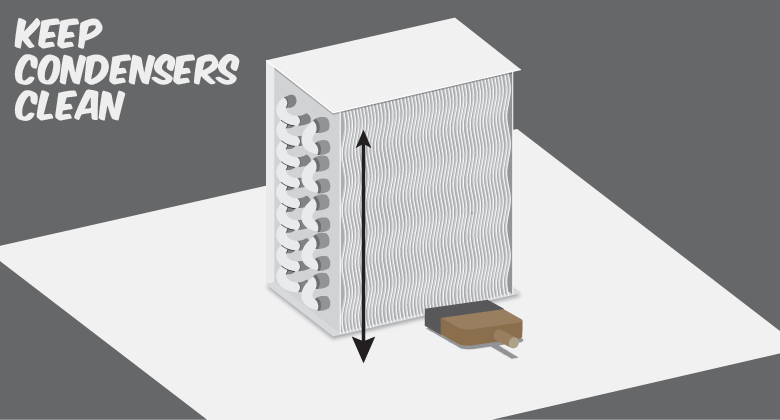Getting things right to begin with can save you from heartache later down the line. Not to mention higher energy bills. When your new fridge or freezer arrives there are a few things you should do to help get things off to a great start.
Williams cabinets and counters are designed to fit through a standard doorway, but if the unit has been tipped or laid on its back, it is important that it is left standing in an upright position for at least 1 hour before switching on.
The cabinet should stand level to ensure correct operation of self-closing doors and proper drainage of condensate from the evaporator.
Choosing where to place your cabinet or counter is essential and can result in dramatic energy savings and considerably less wear and tear on the refrigeration system.
Refrigeration equipment can generate lots of heat. If it is sited in a small unventilated room, especially in warm weather, the room temperature may become excessive. Adequate ventilation will avoid an unpleasant working environment.
It will also prevent the condensing unit from having to run longer and harder to maintain cabinet temperature, which could have a detrimental effect on components and increase energy consumption.
Give cabinets with top-mounted systems 500mm clearance between the top of the cabinet and the ceiling. This will allow engineers access for service and maintenance, as well as space to discharge waste heat.
For all cabinets, ensure a minimum clearance of 50mm is provided around the unit, to ensure efficient and effective performance.
Do not stack boxes on top of or in front of the refrigeration system’s vents and grills as this will affect performance.
Before first loading the unit, allow it to reach its normal operating temperature. When this has been achieved, ensure the load is equally distributed throughout and that air can circulate around and through stored products.
Only ever put pre-refrigerated or ambient product in a refrigerator. Never put warm or hot product in, as this could cause icing of the evaporator which in turn will allow the internal cabinet temperature to rise, making the condenser unit work longer and harder, as well as compromising food safety.

Gaskets are designed to seal the cold air in and to keep the warm air out, which is vital to the efficiency of your unit.
Therefore door gaskets should be checked and cleaned regularly and replaced if damaged.
To clean the gasket, wipe with warm soapy water and a soft cloth, ensuring it is completely dry before closing the door. Do not use a sharp knife to clean or scrape the gasket.
On models with this facility, it is recommended that the key be removed from the lock during normal working use.
This will prevent bending or breaking the key which could result in the lock having to be replaced.
Removing the key will also prevent any possibility of accidentally operating the lock when the door is open, preventing the door from closing properly and causing the interior temperature to rise.
If the cabinet exterior is looked after correctly it will retain an “as new” finish for many years.
Normal day to day cleaning should be carried out with a soft cloth and soapy water, always wipe the cabinet in the same direction as the grain.
Whilst stainless steel is robust, the satin smooth finish can be spoilt by wiping against the grain.
Never use abrasive materials, cleaners or chemical cleaners. These can damage the surface and cause corrosion.
Occasionally, the exterior surface should be polished with a good stainless steel polish to protect it.
The interior should be cleaned regularly with warm soapy water and a soft cloth. Dry thoroughly afterwards and where possible remove all racking and shelving to aid the process.

A dusty condenser coil means your equipment will need to work harder to maintain temperature, thereby increasing energy bills and reducing its shelf life.
To prevent this from happening the condenser, which is part of the refrigeration unit located in the unit compartment, requires cleaning approximately 4 times per year or when the controller indicates the need to do so.
Before starting to clean the condenser, disconnect the unit from the mains supply.
Brush fins vertically with a stiff brush, taking care not to damage them or to push dirt / dust further in, then gently vacuum. Take care not to damage any electrical connections and cables during the removal and cleaning process.
If there are further grease deposits still remaining on the condenser call your Service Provider to carry out a full servic
Most units rely on a drain hole and drip pan to remove condensation, so it’s important that these function properly. Inspect this periodically to ensure there is no blockage.